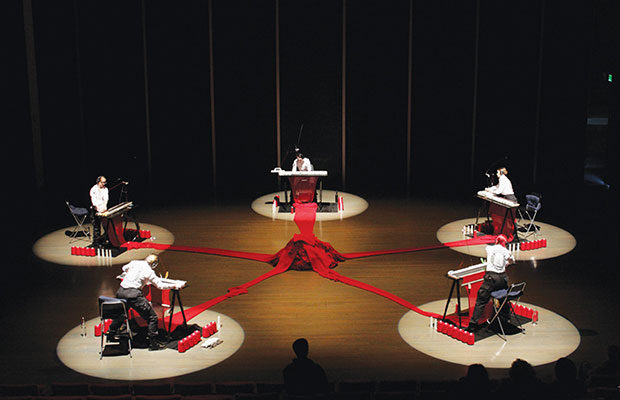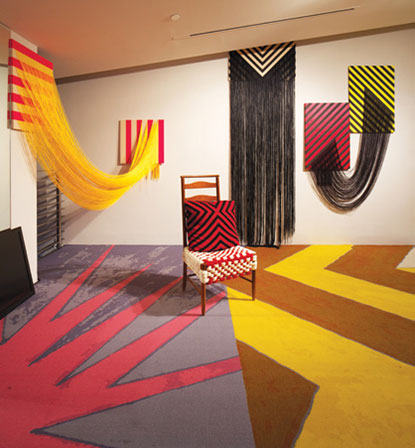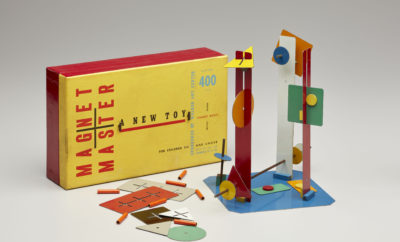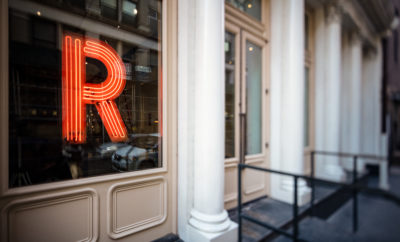 AARON SUNDARESH PHOTO
AARON SUNDARESH PHOTO
Design
The Quiet Riot of Liz Collins
KNITTING IS OFTEN THOUGHT of as quiet and contemplative. For textile artist and designer Liz Collins, it is anything but. Bustling, bright, and even loud, Collins’s work connects fabric with architecture, performance, and installation. With her punky blue hair and a vibe that’s equal parts freewheeling and meticulous, she says, “It’s rewarding for me to be able to be both an artist and a designer. The work can coexist and be in dialogue.”
Collins is inspired by geometry, optics, and interconnectedness. “It’s about energy—the energy that emanates from us, that is all around us in abstract ways but also very literal ways, like electricity,” she says. This approach has led to a long list of projects that include bespoke rugs, museum exhibitions, and a recently completed residency at the Museum of Arts and Design, where she also staged her fifteenth and final Knitting Nation, a performance- and installation-based series for which she is well known.
Collins has crisscrossed art, craft, and design for more than two decades. She has played many roles: fashion and textile designer, indie-craft pioneer, and professor at her alma mater, RISD, where she received her BFA and MFA in textiles. These days she can be found busy at work in her Brooklyn studio. Located in the newly revitalized Industry City, a mecca for creative start-ups, Collins’s gray studio door opens to a wild ride of neon drawings, pattern-on-pattern fabrics, and showers of thread that hang from the ceiling.
The overall result is an immersive environment not unlike Energy Field, her current installation at the Frances Young Tang Teaching Museum and Art Gallery at Skidmore College. The inhabitable artwork, on view until August 2017, is meant as a lounge for both visitors and students; it is a pop fantasy filled with opposing forces. As Collins explains, “I wanted to make a room that is both comforted and agitated…a place to hang out, connect, nap, be transported. A place where you feel a pull to stay and be mesmerized.”
The artist’s work is also included in CounterCraft: Voices of the Indie Craft Community at the Fuller Craft Museum. Curator and longtime admirer Faythe Levine, who has seen Collins’s evolution over many years, has commissioned a site-specific woven wall for the exhibition, on view until July 10. Noting Collins’s influence—especially her Knitting Nation series—Levine explains, “she was a big inspiration with work that was crossing both worlds of craft-activism and fine craft.”
Over eleven years, Collins’s uniformed Knitting Nation team wielded knitting machines to create fabric interventions—engaging passersby with the act of creation and transforming the surrounding spaces— from Occidental College in California to the Institute of Contemporary Art in Boston. The series was a potent reminder of the unseen labor that goes into making cloth and its impressive possibilities when paired with architecture.
Collins’s Potholder rugs, today made bespoke for clients, were originally a way to use up surplus cloth from Knitting Nation. They began as a sort of happy accident when Collins started to weave the fabric on a gigantic scale. At first she was disappointed when testing out the woven rug—it looked like a pot holder. But soon Collins realized that a blown-up version of the summer-camp craft staple wasn’t a downside. “It really resonates for people. They see it and right away they call it a pot holder. I don’t even have to say it.”
Excited by a host of new possibilities—from thread-inspired geometric drawings to lighting with frequent collaborator, industrial designer Harry Allen—Collins is interlacing her past and her future. lizcollins.com | tang.skidmore.edu | fullercraft.org













